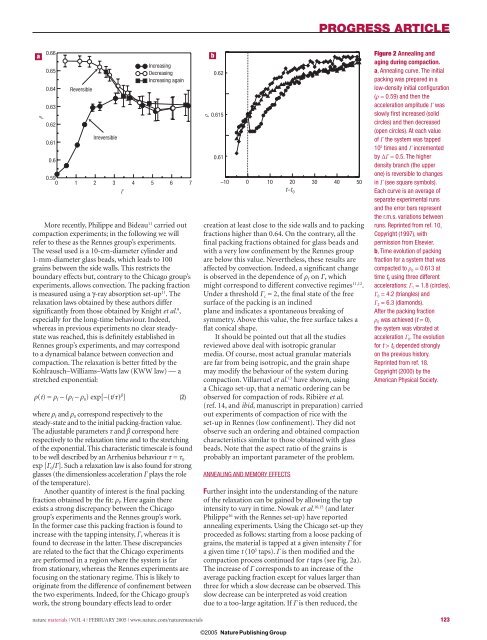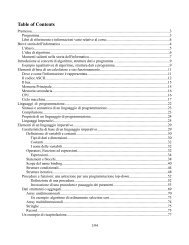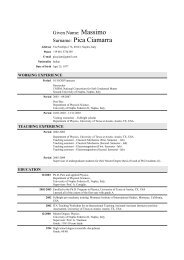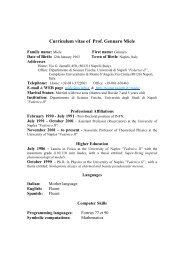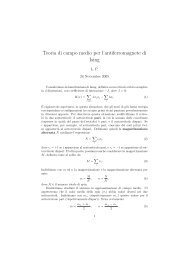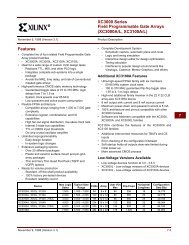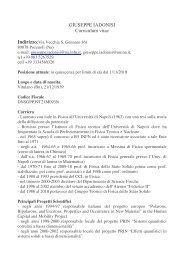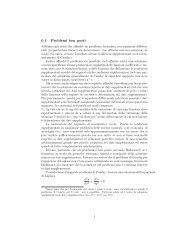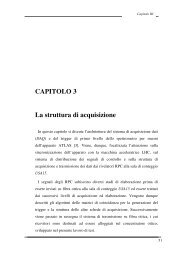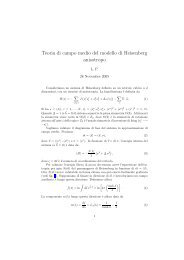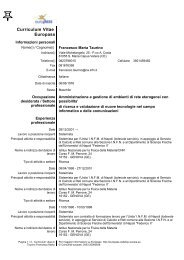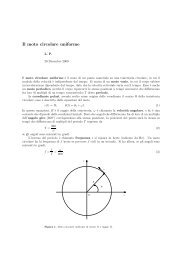Slow relaxation and compaction of granular systems
Slow relaxation and compaction of granular systems
Slow relaxation and compaction of granular systems
Create successful ePaper yourself
Turn your PDF publications into a flip-book with our unique Google optimized e-Paper software.
0.65<br />
0.64<br />
0.63<br />
0.62<br />
0.61<br />
0.6<br />
0.59<br />
0 1 2 3 4 5 6 7<br />
Γ<br />
More recently, Philippe <strong>and</strong> Bideau 11 carried out<br />
<strong>compaction</strong> experiments; in the following we will<br />
refer to these as the Rennes group’s experiments.<br />
The vessel used is a 10-cm-diameter cylinder <strong>and</strong><br />
1-mm-diameter glass beads, which leads to 100<br />
grains between the side walls. This restricts the<br />
boundary effects but, contrary to the Chicago group’s<br />
experiments, allows convection. The packing fraction<br />
is measured using a γ-ray absorption set-up 11 . The<br />
<strong>relaxation</strong> laws obtained by these authors differ<br />
signifi cantly from those obtained by Knight et al. 9 ,<br />
especially for the long-time behaviour. Indeed,<br />
whereas in previous experiments no clear steadystate<br />
was reached, this is defi nitely established in<br />
Rennes group’s experiments, <strong>and</strong> may correspond<br />
to a dynamical balance between convection <strong>and</strong><br />
<strong>compaction</strong>. The <strong>relaxation</strong> is better fi tted by the<br />
Kohlrausch–Williams–Watts law (KWW law) — a<br />
stretched exponential:<br />
ρ(t) = ρ f – (ρ f – ρ 0) exp[–(t/τ) β ] (2)<br />
where ρ f <strong>and</strong> ρ 0 correspond respectively to the<br />
steady-state <strong>and</strong> to the initial packing-fraction value.<br />
The adjustable parameters τ <strong>and</strong> β correspond here<br />
respectively to the <strong>relaxation</strong> time <strong>and</strong> to the stretching<br />
<strong>of</strong> the exponential. This characteristic timescale is found<br />
to be well described by an Arrhenius behaviour τ = τ 0<br />
exp [Γ 0/Γ]. Such a <strong>relaxation</strong> law is also found for strong<br />
glasses (the dimensionless acceleration Γ plays the role<br />
<strong>of</strong> the temperature).<br />
Another quantity <strong>of</strong> interest is the fi nal packing<br />
fraction obtained by the fi t: ρ f. Here again there<br />
exists a strong discrepancy between the Chicago<br />
group’s experiments <strong>and</strong> the Rennes group’s work.<br />
In the former case this packing fraction is found to<br />
increase with the tapping intensity, Γ, whereas it is<br />
found to decrease in the latter. These discrepancies<br />
are related to the fact that the Chicago experiments<br />
are performed in a region where the system is far<br />
from stationary, whereas the Rennes experiments are<br />
focusing on the stationary regime. This is likely to<br />
originate from the difference <strong>of</strong> confi nement between<br />
the two experiments. Indeed, for the Chicago group’s<br />
work, the strong boundary effects lead to order<br />
ρ<br />
creation at least close to the side walls <strong>and</strong> to packing<br />
fractions higher than 0.64. On the contrary, all the<br />
fi nal packing fractions obtained for glass beads <strong>and</strong><br />
with a very low confi nement by the Rennes group<br />
are below this value. Nevertheless, these results are<br />
affected by convection. Indeed, a signifi cant change<br />
is observed in the dependence <strong>of</strong> ρ f on Γ, which<br />
might correspond to different convective regimes 11,12 .<br />
Under a threshold Γ c ≈ 2, the fi nal state <strong>of</strong> the free<br />
surface <strong>of</strong> the packing is an inclined<br />
plane <strong>and</strong> indicates a spontaneous breaking <strong>of</strong><br />
symmetry. Above this value, the free surface takes a<br />
fl at conical shape.<br />
It should be pointed out that all the studies<br />
reviewed above deal with isotropic <strong>granular</strong><br />
media. Of course, most actual <strong>granular</strong> materials<br />
are far from being isotropic, <strong>and</strong> the grain shape<br />
may modify the behaviour <strong>of</strong> the system during<br />
<strong>compaction</strong>. Villarruel et al. 13 have shown, using<br />
a Chicago set-up, that a nematic ordering can be<br />
observed for <strong>compaction</strong> <strong>of</strong> rods. Ribière et al.<br />
(ref. 14, <strong>and</strong> ibid, manuscript in preparation) carried<br />
out experiments <strong>of</strong> <strong>compaction</strong> <strong>of</strong> rice with the<br />
set-up in Rennes (low confi nement). They did not<br />
observe such an ordering <strong>and</strong> obtained <strong>compaction</strong><br />
characteristics similar to those obtained with glass<br />
beads. Note that the aspect ratio <strong>of</strong> the grains is<br />
probably an important parameter <strong>of</strong> the problem.<br />
ANNEALING AND MEMORY EFFECTS<br />
Further insight into the underst<strong>and</strong>ing <strong>of</strong> the nature<br />
<strong>of</strong> the <strong>relaxation</strong> can be gained by allowing the tap<br />
intensity to vary in time. Nowak et al. 10,15 (<strong>and</strong> later<br />
Philippe 16 with the Rennes set-up) have reported<br />
annealing experiments. Using the Chicago set-up they<br />
proceeded as follows: starting from a loose packing <strong>of</strong><br />
grains, the material is tapped at a given intensity Γ for<br />
a given time t (10 5 taps). Γ is then modifi ed <strong>and</strong> the<br />
<strong>compaction</strong> process continued for t taps (see Fig. 2a).<br />
The increase <strong>of</strong> Γ corresponds to an increase <strong>of</strong> the<br />
average packing fraction except for values larger than<br />
three for which a slow decrease can be observed. This<br />
slow decrease can be interpreted as void creation<br />
due to a too-large agitation. If Γ is then reduced, the<br />
PROGRESS ARTICLE<br />
0.66<br />
a b Figure 2 Annealing <strong>and</strong><br />
ρ<br />
Reversible<br />
Irreversible<br />
Increasing<br />
Decreasing<br />
Increasing again<br />
0.62<br />
0.615<br />
0.61<br />
–10 0 10 20 30 40 50<br />
t–t 0<br />
aging during <strong>compaction</strong>.<br />
a, Annealing curve. The initial<br />
packing was prepared in a<br />
low-density initial confi guration<br />
(ρ ≈ 0.59) <strong>and</strong> then the<br />
acceleration amplitude Γ was<br />
slowly fi rst increased (solid<br />
circles) <strong>and</strong> then decreased<br />
(open circles). At each value<br />
<strong>of</strong> Γ the system was tapped<br />
10 5 times <strong>and</strong> Γ incremented<br />
by ΔΓ ≈ 0.5. The higher<br />
density branch (the upper<br />
one) is reversible to changes<br />
in Γ (see square symbols).<br />
Each curve is an average <strong>of</strong><br />
separate experimental runs<br />
<strong>and</strong> the error bars represent<br />
the r.m.s. variations between<br />
runs. Reprinted from ref. 10,<br />
Copyright (1997), with<br />
permission from Elsevier.<br />
b, Time evolution <strong>of</strong> packing<br />
fraction for a system that was<br />
compacted to ρ 0 = 0.613 at<br />
time t 0 using three different<br />
accelerations: Γ 1 = 1.8 (circles),<br />
Γ 0 = 4.2 (triangles) <strong>and</strong><br />
Γ 2 = 6.3 (diamonds).<br />
After the packing fraction<br />
ρ 0 was achieved (t = 0),<br />
the system was vibrated at<br />
acceleration Γ 0. The evolution<br />
for t > t 0 depended strongly<br />
on the previous history.<br />
Reprinted from ref. 18.<br />
Copyright (2000) by the<br />
American Physical Society.<br />
nature materials | VOL 4 | FEBRUARY 2005 | www.nature.com/naturematerials 123<br />
© 2005<br />
Nature Publishing Group


